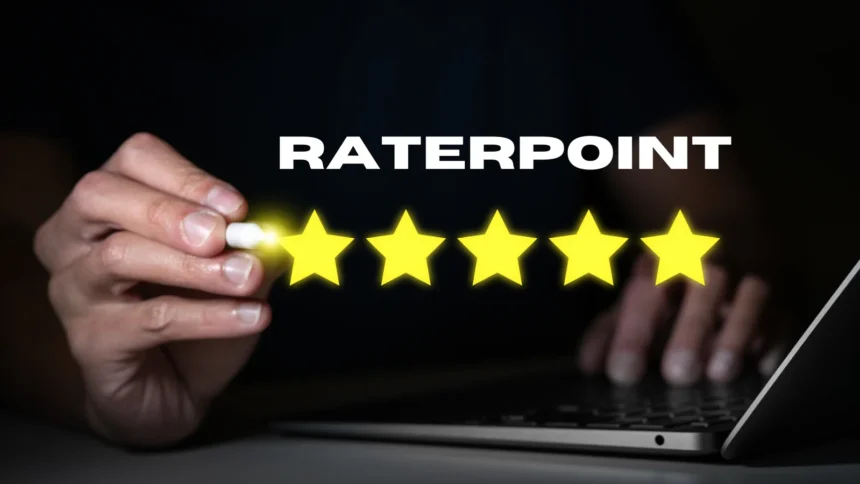Introduction to raterpoint
Feedback is the lifeblood of any successful organization. It drives growth, ignites innovation, and fosters a culture of continuous improvement. But how do we ensure that feedback is effective and meaningful? Enter raterpoint—a powerful tool designed to streamline the feedback process in the workplace. With its user-friendly interface and innovative features, raterpoint transforms traditional feedback mechanisms into dynamic exchanges that promote engagement and development.
In today’s fast-paced work environment, where every moment counts, having a reliable system for gathering insights can make all the difference. Whether you’re a manager aiming to uplift your team or an employee seeking personal growth, understanding how to leverage raterpoint effectively can unlock new levels of productivity and satisfaction in your work life. Let’s explore why feedback matters so much and how raterpoint can help elevate this essential practice within your organization.
The Importance of Feedback in the Workplace
Feedback is a cornerstone of any thriving workplace. It fosters growth, encourages open communication, and builds trust among team members.
When employees receive constructive feedback, they gain clarity on expectations. This transparency helps reduce confusion and aligns individual goals with the organization’s objectives.
Moreover, effective feedback nurtures a culture of continuous improvement. Employees feel empowered to enhance their skills and contribute more meaningfully to projects.
For supervisors, providing timely and specific feedback helps in identifying strengths and areas for development within the team. It creates opportunities for training or mentorship that can elevate performance levels significantly.
In essence, fostering an environment where feedback is welcomed can transform workplaces into dynamic spaces where innovation flourishes. Investing time in this process pays off immensely as it cultivates happier employees who are engaged and motivated to excel.
How raterpoint Can Help Improve Feedback
Raterpoint revolutionizes the feedback process by providing a structured platform. This ensures that both givers and receivers understand expectations clearly.
With customizable templates, users can tailor their feedback to meet specific goals. This adaptability fosters more relevant conversations about performance.
The analytics feature is another game-changer. It allows teams to track patterns and trends over time. Recognizing recurring issues helps identify areas needing attention or improvement.
Moreover, raterpoint encourages an open dialogue culture within organizations. Employees feel empowered to share insights without apprehension, leading to constructive exchanges and stronger teamwork.
Feedback becomes a continuous loop rather than a one-off event. Regular check-ins facilitate ongoing development, making it easier for employees to adapt and grow in real-time.
Step-by-Step Guide on Using raterpoint for Effective Feedback
Getting started with raterpoint is simple and user-friendly. First, create an account by visiting the raterpoint website. Input your basic information to set up your profile.
Once registered, familiarize yourself with the dashboard. It’s designed for easy navigation between tasks and feedback categories.
Next, identify the areas where you want to give or receive feedback. This could range from project performance to interpersonal skills.
When ready, select a specific team member or colleague for feedback sessions. Craft your message clearly and constructively; focus on behaviors rather than personal attributes.
After sending out your feedback request, encourage open dialogue about it. The response can provide valuable insights into how others perceive their work.
Track progress over time using raterpoint’s analytics features. These tools help visualize improvements and highlight ongoing challenges effectively.
Best Practices for Giving and Receiving Feedback through raterpoint
When using raterpoint, clarity is key. Be specific about the behavior or outcome you’re addressing. This helps avoid misunderstandings and allows for focused improvement.
Timing also matters. Give feedback close to the event in question. This ensures that details are fresh in everyone’s mind and makes the conversation more relevant.
Encourage an open dialogue when receiving feedback through raterpoint. Listen actively and ask questions if something isn’t clear. This fosters a culture of continuous learning.
Remember to balance positive comments with constructive criticism. Highlighting strengths alongside areas for improvement boosts morale and encourages growth.
Follow up on previous discussions to track progress. Showing commitment reinforces trust between team members while highlighting raterpoint as a tool for development rather than just evaluation.
Success Stories: Companies and Individuals Who Have Benefited from Using raterpoint
Many organizations have embraced raterpoint, discovering its transformative power in enhancing feedback mechanisms.
One tech startup reported a 30% increase in employee satisfaction after implementing raterpoint. By utilizing the platform’s structured feedback approach, team members felt more heard and appreciated.
A global retail chain experienced improved customer service ratings as employees received regular, constructive input through raterpoint. The result? A noticeable uptick in sales and customer loyalty.
Individuals also thrive with this tool. A freelance designer leveraged raterpoint to gather client feedback effectively. With targeted insights, she refined her work style and significantly boosted her project success rate.
These examples showcase how both companies and individuals are harnessing the potential of raterpoint to foster an environment where continuous improvement is not just encouraged but celebrated.
Conclusion: Embracing Continuous Improvement with raterpoint
Embracing continuous improvement is essential in today’s dynamic workplace. Raterpoint offers a transformative approach to feedback that empowers teams and individuals alike. By integrating raterpoint into your workflow, you foster an environment where constructive criticism becomes the norm.
Feedback shouldn’t be a rare event; it should be part of the daily conversation. With raterpoint’s user-friendly platform, engaging with team members about performance and progress feels seamless.
Encouraging open dialogue helps build trust among colleagues. As users share their experiences through raterpoint, they cultivate a culture focused on growth rather than blame.
When feedback becomes routine, everyone benefits—productivity rises, satisfaction grows, and collaboration flourishes. Investing in tools like raterpoint not only enhances individual performance but also elevates entire organizations towards success.
Introduction to Raterpoint
Raterpoint is transforming the way organizations handle feedback. This innovative platform streamlines communication and fosters a culture of continuous improvement.
With an intuitive interface, Raterpoint makes it easy for teams to share insights and suggestions. Companies can engage employees at all levels, ensuring that everyone’s voice is heard.
The tool empowers users by providing structured formats for giving and receiving feedback. This clarity helps eliminate confusion and promotes constructive conversations.
Whether you’re a manager or an employee, Raterpoint offers valuable resources to enhance your feedback experience. It encourages open dialogue, leading to stronger relationships within teams.
By leveraging technology in this way, Raterpoint paves the path toward more effective workplace dynamics. Embracing such tools can lead to significant growth both individually and collectively in any organization.
The Importance of Feedback in the Workplace
Feedback is a crucial element of any thriving workplace. It fosters open communication and builds trust among team members. When employees receive constructive feedback, they understand their strengths and areas for improvement.
Moreover, regular feedback can enhance performance. Employees who know what’s expected are more likely to meet those expectations. This clarity often leads to increased motivation and job satisfaction.
In addition, feedback supports professional growth. It provides insights that help individuals develop new skills and refine existing ones. A culture that embraces continuous feedback encourages learning from mistakes rather than fearing them.
The right kind of feedback promotes collaboration within teams. It creates an environment where ideas flow freely, leading to innovative solutions and stronger relationships among colleagues.
How Raterpoint Can Help Improve Feedback Processes
Raterpoint revolutionizes the way feedback is delivered and received in organizations. It provides a structured platform that encourages open communication among team members.
With Raterpoint, users can easily give and receive feedback in real-time. This immediacy helps to address issues before they escalate, fostering a more proactive approach to improvement.
The tool also offers customizable templates tailored to different roles or situations. This flexibility ensures that the feedback process remains relevant and effective across various departments.
Moreover, Raterpoint’s analytics feature allows teams to track progress over time. By identifying trends, organizations can make informed decisions about their development strategies.
It creates an inclusive environment where everyone feels heard. When employees see their input valued through Rater point, engagement naturally increases within the workplace.
Step-by-Step Guide for Using Rater point
Getting started with rater point is straightforward. First, create an account on their website. This process takes just a few minutes.
Once logged in, familiarize yourself with the dashboard. You’ll find various tools designed to streamline feedback collection and analysis.
Next, set up your first feedback request. Choose the parameters that suit your needs—whether it’s peer reviews or manager evaluations.
After that, share the link generated by rate rpoint with your team members or colleagues. Make sure everyone understands how to provide thoughtful responses.
Monitoring progress is essential too. Keep an eye on participation rates through the analytics features available within the platform.
Analyze the feedback received to identify patterns and areas for improvement. The insights gained will be invaluable as you refine processes and enhance communication within your workplace.
Best Practices for Giving Effective Feedback Using Rater point
When using Rater point, clarity is key. Be direct in your comments to ensure the recipient understands your feedback without ambiguity.
Focus on specific examples from recent projects or tasks. This makes your feedback tangible and actionable, allowing others to see exactly where improvements can be made.
Encourage a two-way conversation. Ask questions that prompt discussion and reflect understanding of the points raised. This engagement fosters a more productive relationship.
Timing matters too; provide feedback soon after an event or project completion for maximum relevance.
Balance critical insights with positive reinforcement. Acknowledging strengths alongside areas for improvement creates a supportive atmosphere and motivates growth through Rater point’s platform.
Case Studies: Success Stories of Companies Using Rater point
Several companies have transformed their feedback processes using rater point. One notable case is Tech Innovators, a mid-sized tech firm struggling with employee engagement. By integrating rater point into their performance reviews, they noticed a significant increase in communication between teams. Employees felt more valued and understood.
Another success story comes from Green Solutions, an environmental consulting agency. They implemented rater point to gather client feedback on project delivery. This led to actionable insights that improved service quality and boosted client satisfaction ratings by 30% within six months.
Then there’s Creative Minds Agency. They leveraged rater point for peer reviews among creative teams. This initiative fostered a culture of constructive criticism and collaboration, resulting in higher-quality outputs and increased team morale.
These examples illustrate how diverse organizations can harness the power of rater point to enhance feedback mechanisms effectively. Each company witnessed tangible benefits tailored to its unique challenges.
faqs
When it comes to feedback, many questions may arise. Here are some common queries about rate point and how it can enhance your feedback processes.
**What is rater point?**
Rater point is a cutting-edge platform designed for collecting and managing feedback seamlessly. It helps teams communicate more effectively, enabling constructive dialogue that fosters personal and professional growth.
**Why is feedback important in the workplace?**
Feedback promotes improvement, accountability, and collaboration. It nurtures a culture of trust where employees feel valued and motivated to perform better.
**How does rater point improve the feedback process?**
Raterpoint streamlines communication by providing structured templates for giving and receiving feedback. This ensures consistency while allowing room for personalization based on individual needs.
**Can I use rater point for team reviews as well?**
Absolutely! Raterpoint is versatile enough to be employed during peer reviews or even one-on-one sessions between managers and employees, making it an essential tool across various scenarios.
**Are there any best practices when using raterpoint?**
Yes, clarity is key when delivering feedback through rater point. Be specific about what you’re addressing, focus on behaviors rather than personality traits, and encourage open dialogue during discussions.
By integrating these insights into your routine with rater point, you’ll not only enhance communication but also cultivate an environment of continuous improvement within your organization.



